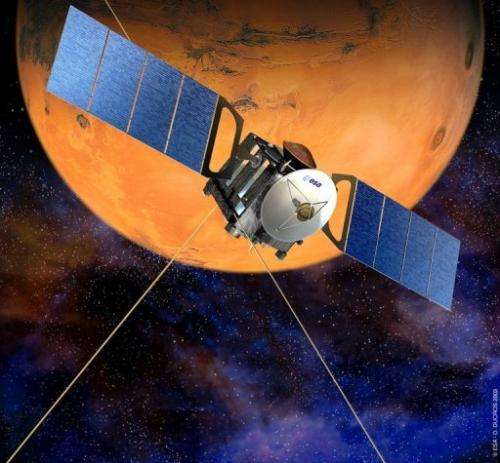10 years on, Europe salutes its Martian scout

It was built on a relative shoestring, was completed in just five years and was designed to survive for just 687 days. Ten years later, after more than 12,000 swings around the Red Planet, Europe's Mars Express is still going strong.
Along with NASA's massively successful fleet of probes and landers, the orbital scout has helped pull aside the veil of secrecy surrounding our sister planet.
It has pointed to the presence of subterranean water and a wild volcanic past and shed light on the bizarrely-pocked martian moons.
"The mission has already provided countless breathtaking views of Mars in three dimensions," says the European Space Agency (ESA).
"It has traced the history of water across the globe, demonstrating that Mars once harboured environmental conditions that may have been suitable for life."
The orbiter's seven instruments have detected minerals that form only in the presence of water and seen underground formations of water ice. Scans of the surface suggest volcanism on Mars may have persisted until recent times.
And its chemical analysis of the martian atmosphere indicates the possible presence of methane—which on Earth is attributed to active volcanism and biological life.
The first European mission to explore another planet, Mars Express was launched from Baikonur cosmodrome by a Russian Soyuz rocket on June 2 2003, just when Earth and Mars were approaching their closest alignment in 17 years.
The mission ran into a humiliating setback that December with the crash of a small British-built lander, Beagle-2, whose loss remains unexplained to this day.
But the mission, designed to last for one martian year, has already been extended four times, and its latest closure date is for the end of 2014.
Mars Express is proving to be so sturdy that its builder, Astrium, believes it may even be around in January 2016 to welcome ExoMars, an unmanned European-Russian mission that will explore the methane enigma.
"Nobody would have believed it back then," says the German Aerospace Center (DLR), which developed what is arguably the star instrument aboard Mars Express: a stereoscopic camera that has imaged more than two-thirds of the planet in colour and 3D to a resolution of 20 metres (65 feet) per pixel.
Memorable images include Mars' icy southern pole and Olympus Mons which towers 26,000 metres (84,500 feet) above the surrounding plains.
Conceived as a streamlined, low-cost project, Mars Express was a gamble for ESA.
It broke with conventional thinking that planetary exploration required individually-tailored probes that took a decade to make and inevitably cost a billion bucks apiece.
To save costs, ESA's contractors essentially resorted to mass production.
The basic box-like design for Mars Express, and for a sister spacecraft called Venus Express—launched in 2005 and also doing fine—is the same platform as for Rosetta, a comet-chasing probe whose mission is due to climax next year.
So far, exploration of Mars has cost ESA 300 million euros ($390 million), which is minute for a mission that has returned such wonders.
And not a single life has been placed at risk.
Last week came proof that a manned trip to Mars would be health-threatening unless today's chemical rockets are replaced by much faster transport.
Measurements made aboard the Mars Science Laboratory, an unmanned NASA rover and mobile lab that landed in August 2012 showed exposure to high levels of radiation during its 253-day trip.
These are particles spewed out by the Sun, or coming from beyond our Solar System, that can slice through DNA and boost the risk of cancer.
"In terms of accumulated dose, it's like getting a whole-body CT scan once every five or six days," said Cary Zeitlin of the Southwest Research Institute's (SwRI) Space Science and Engineering Division.
"Radiation exposure at the level we measured is right at the edge, or possibly over the edge of what is considered acceptable in terms of career exposure limits defined by NASA and other space agencies."
© 2013 AFP





















